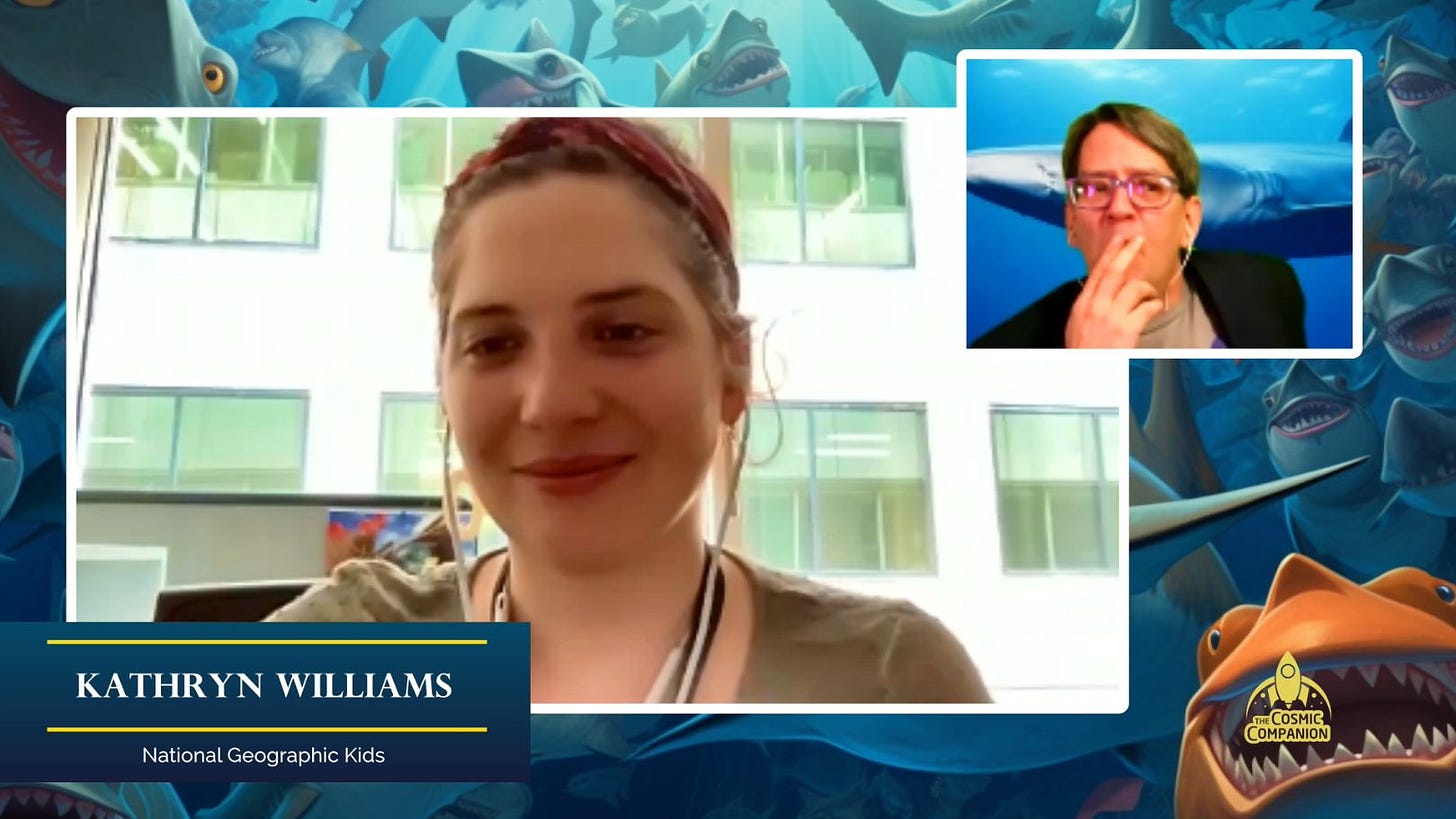Hello everyone!
This week on The Cosmic Companion, we look at Surviving Extinction, talking with Nat Geo’s Kathryn Williams, editor of Weird but True! Sharks!
Earth has, so far, seen five major extinction events, with the sixth happening now, thanks to global climate change.
Listen to the podcast here, or watch this episode as a video!
These global dying events wiped out vast numbers of species, reshuffling the deck of life.
However, one power trio — the Masters of Survival — tardigrades, horseshoe crabs, and sharks, each shrugged off several of these calamities like it was a couple of bad gigs at a rundown bar.
[[We’re the Masters of Survival… Your extinction is our revival… Yeah!]]
First, let’s rewind the clock to 443 million years ago, the Ordovician-Silurian extinction. Life just before this event was like a wild dance party in the ocean, filled with creatures like this adorable trilobite right here. {left hand} Her name is Tilly. Say hello, Tilly! [[Hello, Tilly!]]
But then, bam! Climate change, sea level fluctuations, and an icy cold climate crashed the party. Most species were left wondering what happened, but not our hilarious heroes, the tardigrades. These little critters managed to shrug off the catastrophe and continue their adorable shenanigans, partying like it’s still the Ordovician era. Incidentally, trilobites also escaped extinction this time, but their luck would run out, eventually. Sorry, Tilly!
Next on our adventure of life’s little mishaps are the Late Devonian extinctions, a series of die-offs stretching from 420 to 360 million years ago.
Given the 60 million-year long, four-act marathon performance of this extinction, it is unlikely one cause was responsible for the Devonian extinction, but the rise of Devo hats as a fashion item may have played a role.
But amidst the chaos, our ever-present sharks swam against the tide. These toothy jesters made sure that even if the waters were a bit murky, there would still be plenty of chuckles left for the future.
Here comes the big one, Elizabeth! About 252 million years ago, The Permian-Triassic extinction (also known as the great dying) obliterated 95% of all marine species and 70% of terrestrial life. Picture a stand-up routine where 95% of the audience suddenly disappears. (Kind of like my last live performance).
But guess who had the last laugh? Horseshoe crabs, that’s who. Those masters of survival managed to ride out the apocalypse once more. Incidentally, this was also the first major extinction which cockroaches survived. It would NOT be their last.
Now, let’s groove to the beat of the End Triassic extinction, which dished out its destruction from around 252 to 201 million years ago. Continental drift and 40,000 years of massive volcanic eruptions drove global temperatures up 10–15 degrees Celsius, acidifying the oceans.
Marine organisms bit the dust far and wide, losing three-quarters of their diversity. However, resilient survivors emerged from the ashes. Enter the age of dinosaurs! Ancient reptiles called dinosauromorphs took the spotlight as the opening act for the age of dinosaurs.
Finally, we shimmy our way to the Cretaceous-Paleogene extinction, roughly 66 million years ago. It was the ultimate cosmic collision — the party crasher of all party crashers. A colossal asteroid hit Earth, triggering a celestial disco ball of devastation.
Dinosaurs (and trilobites) met their end after 165 million years of roaming the planet. Yet, amidst the chaos, mammals scurried in the shadows, and birds seized the opportunity to emerge from the sidelines and claim the dance floor for themselves.
While life all around the world perished time and again, sharks still played their regular gig in the oceans of Earth. Next up, we talk with Kathryn Williams about Nat Geo Kids’ new book, Weird but True! Sharks!
Conditions on other worlds are harsh, at least from the standpoint of an Earthling. Even the most habitable of worlds are no place to spend a holiday.
Life could saturate the Cosmos, and lifeforms everywhere will face their own extinction events.
The ability to adapt, to migrate, and to move, assists species here on Earth in surviving extinction events. The same is likely to be true elsewhere as well.
Perhaps some extraterrestrial beings possess a knack for genetic versatility, capable of swiftly reshuffling their biological code, dealing themselves a winning hand to overcome impending doom.
[[I’m Bick, and this is my partner, Triller. Now, we are going to rearrange our genetic code to avoid an extinction. And… Presto.]]
Here on Earth, extremophiles live in the most unwelcome environments. Alien lifeforms may thrive in conditions most or all Earthlings would consider inhospitable. Some likely take comfort on worlds with scorching temperatures, acidic oceans, or even in the depths of frigid interstellar space, finding refuge in cosmic corners that others fear to tread.
Some extraterrestrial lifeforms might possess an uncanny ability to enter states of suspended animation, making them the ultimate cosmic nap-takers. As their world faces a cataclysmic event, these interstellar dozers take a cosmic siesta, preserving their vital energies until the storm has passed. With a celestial snore and a cosmic yawn, they then awaken from their slumber, ready to continue their otherworldly adventures.
Intelligent life also allows the possibility of interstellar migration, as alien lifeforms might seek new cosmic frontiers to call home. Their ability to adapt, combined with a means and the willingness to travel beyond their planetary cradle, allows them to escape the clutches of extinction.
Next week on The Cosmic Companion, we offer up A Traveler’s Guide to Private Spaceflight. We will take a look at the past and future of private spaceflight, talking with Ashlee Vance, author of When the Heavens Went on Sale. Make sure to join us starting on 27 May.
Sign up for our Substack newsletter at TheCosmicCompanion.com and never miss an episode of our show.
If you enjoyed this episode of The Cosmic Companion, please organize a flash mob to sing a tribute to our series, performed at Times Square, along with first-rate choreography. If that is not possible (for some strange reason), please comment, follow, share, and tell your friends about the show. It’d be mighty kind of ya. Mighty kind.
Clear skies!
James
























Surviving Extinction with Kathyrn Williams, Nat Geo Kids